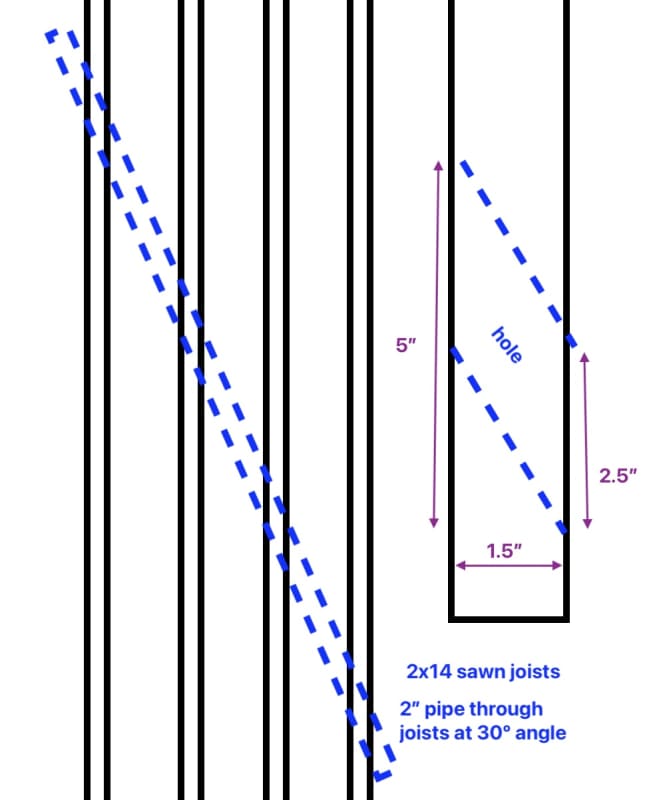Navigation
Install the app
How to install the app on iOS
Follow along with the video below to see how to install our site as a web app on your home screen.
Note: This feature may not be available in some browsers.
More options
Style variation
-
Congratulations TugboatEng on being selected by the Eng-Tips community for having the most helpful posts in the forums last week. Way to Go!
You are using an out of date browser. It may not display this or other websites correctly.
You should upgrade or use an alternative browser.
You should upgrade or use an alternative browser.
Diagonal holes in framing members? 2
- Thread starter covfefe
- Start date
- Status
- Not open for further replies.
Interesting question. Not sure what 1/3 rules you are referring to, but for the purpose of analysis, I would assume a 2.5" diameter hole since that is the amount of material removed if you were to slice a cross section along the length of the joist. A fancy FEA analysis might say otherwise, but I would not expect much of a difference in the results. I'm actually impressed by the skill used to drill such a hole at that angle over several joists such that each successive hole lines up.
I vote for the 5". Those rules are entirely empirical and not really based on any real analysis, so it's best to fail conservative on their application. How deep is it? If it's only an inch deep, you might be able to justify it based on the fact that 1x4 let in bracing is a thing. Never mind - I see the pipe size.
5" here as well + tolerance for the contractor working the bit all over the place to drill a diagonal hole. Don't go diagonal along with the reduced section hit and difficulty in drilling align holes on an angle, the pipe would no longer have some deformation compatibility of the structural members along the length increasing the chance to stress the pipe.
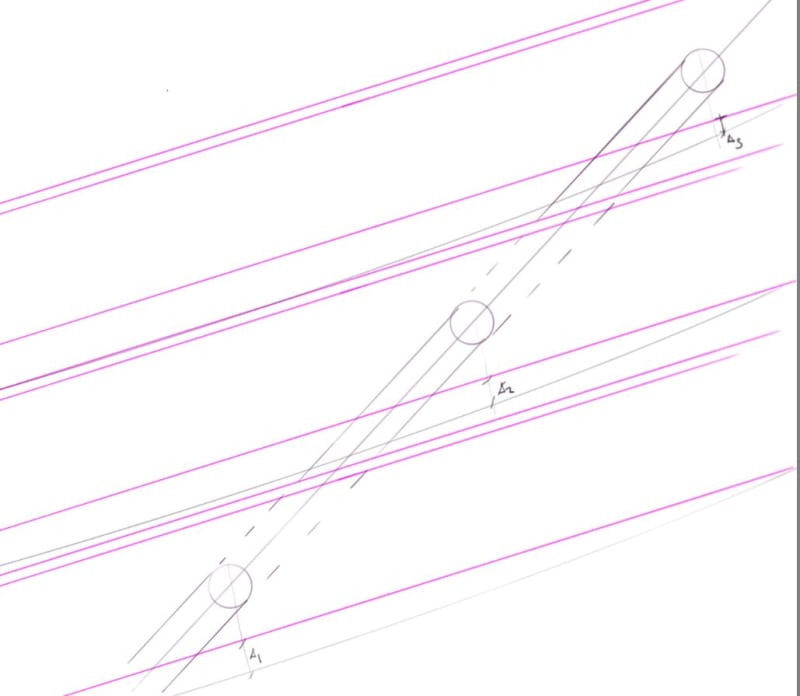
I'm making a thing: (It's no Kootware and it will probably break but it's alive!)

I'm making a thing: (It's no Kootware and it will probably break but it's alive!)
I'm out of my element here (I do industrial machine design - not structural or with wood), but if you want an opinion, I'd say go with assuming it's a 5" hole.
Taking the question and assuming that it is valid to assume the length to be considered is only the length on one face (2.5" in your example) and then stretching to apply this assumption to other situations shows that it would become illogical. If you took the same hole and made it nearly parallel to the member, the issue becomes exaggerated. At 5 degrees (as opposed to 30 degrees) the variation between the length on one face and the length through the width of the member. It becomes obvious that assuming the hole can be treated the same as if it went straight through is not an accurate representation. So at the very minimum, you would need to justify that the effect is minimal for certain conditions (e.g. it's ok to assume a 2.5" hole as long as the hole is between 30-90 degrees with respect to the member)
Second argument: Consider the material taken away by cutting the hole. Assuming a 2.5" hole would mean assuming that the additional material taken away by drilling through at an angle is negligible to the analysis.
Again, I'm out of my element here, so take my opinions for what they're worth.
SirPhobos
Taking the question and assuming that it is valid to assume the length to be considered is only the length on one face (2.5" in your example) and then stretching to apply this assumption to other situations shows that it would become illogical. If you took the same hole and made it nearly parallel to the member, the issue becomes exaggerated. At 5 degrees (as opposed to 30 degrees) the variation between the length on one face and the length through the width of the member. It becomes obvious that assuming the hole can be treated the same as if it went straight through is not an accurate representation. So at the very minimum, you would need to justify that the effect is minimal for certain conditions (e.g. it's ok to assume a 2.5" hole as long as the hole is between 30-90 degrees with respect to the member)
Second argument: Consider the material taken away by cutting the hole. Assuming a 2.5" hole would mean assuming that the additional material taken away by drilling through at an angle is negligible to the analysis.
Again, I'm out of my element here, so take my opinions for what they're worth.
SirPhobos
Assuming this is typical field work done with normal tools one sees on site, I doubt this will be done as a diagonal hole. Anyone that has used a hole saw knows how terrible they are even if used at a 90d angle. This looks a lot like recip saw work, so I vote 5".
That's asking for someone to use a hole saw perpendicular to the stud and then play connect-the dots with a sawzall.
Have I been too long away - isn't the hypotenuse of a 30-60-90 triangle 2X the smallest length? That would make the vertical opening 5 inches, not 2.5 and add 1.7*1.5 to the vertical overlap to be 7.55 inches, at least if the angle is toward the vertical.
If it's more horizontal then the vertical oval is about 3 inches high and the vertical offset nearly 1 inch, so that would be 4 inch vertical overlap.
One could lay the boards side by side with a step the their bottom ends matching the angle over that gap to make up for the offsets to make marking them easier and allow one to bore them before installation.
Have I been too long away - isn't the hypotenuse of a 30-60-90 triangle 2X the smallest length? That would make the vertical opening 5 inches, not 2.5 and add 1.7*1.5 to the vertical overlap to be 7.55 inches, at least if the angle is toward the vertical.
If it's more horizontal then the vertical oval is about 3 inches high and the vertical offset nearly 1 inch, so that would be 4 inch vertical overlap.
One could lay the boards side by side with a step the their bottom ends matching the angle over that gap to make up for the offsets to make marking them easier and allow one to bore them before installation.
XR, yes, a Forstner bit would work, but not fun. I almost broke my wrist doing a reno in a cabinet where I had a 1/2 hp drill and 3" Forstner. Electricians have crazy long auger bits, but I doubt that would work here. Timber framers use auger bits as well.
Dave, if this a typical job the framer does not cut the holes. Mech trades come in after the fact, and they can be a little crude to get their job done. The worst would try to use an electric chainsaw for this job.
Dave, if this a typical job the framer does not cut the holes. Mech trades come in after the fact, and they can be a little crude to get their job done. The worst would try to use an electric chainsaw for this job.
I'm going to be a dissenting voice here. From a purely theoretical view, I think you can consider the hole width as 2.5". If you look at the joist slice by slice, each slice just has a 2.5" wide by 2" tall hole. That's the only damage through each slice, and if you consider it as a entirety it could be considered as a 2.5" wide hole.
But...site conditions are going to make this much worse, so don't run numbers too tight.
But...site conditions are going to make this much worse, so don't run numbers too tight.
I'm in the 2.5" camp as well. Or, more accurately, whatever the diameter of the physical hole winds up being. My reasoning:
1) My understanding of non-imperfection related shear failure in wood is that it's primarily about the horizontal shear planes.
2) Following from #1, it seems to me that the parameter of interest is the amount of area lost on a hypothetical, horizontal shear plane.
3) I did a little math on #2 in an attempt to work out an effective hole diameter. Turns out that's just the regular hole diameter. Still, my 8th grade algebra/trig teacher would be proud.
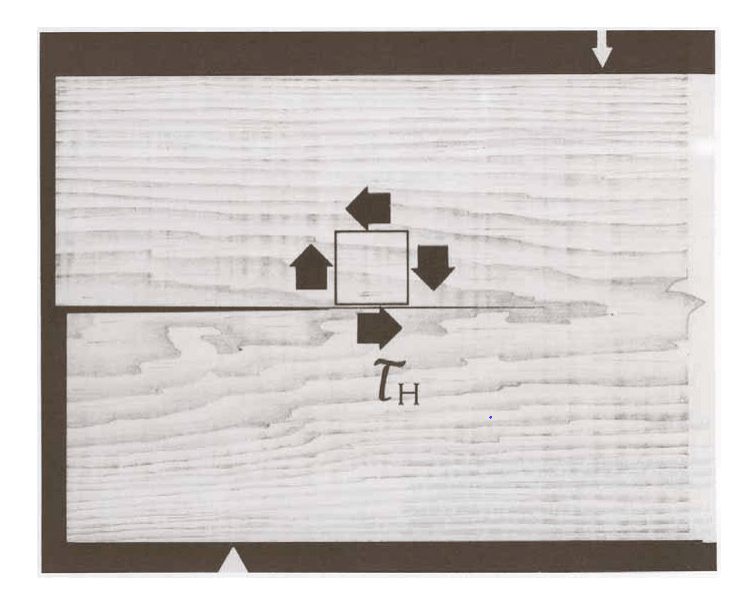
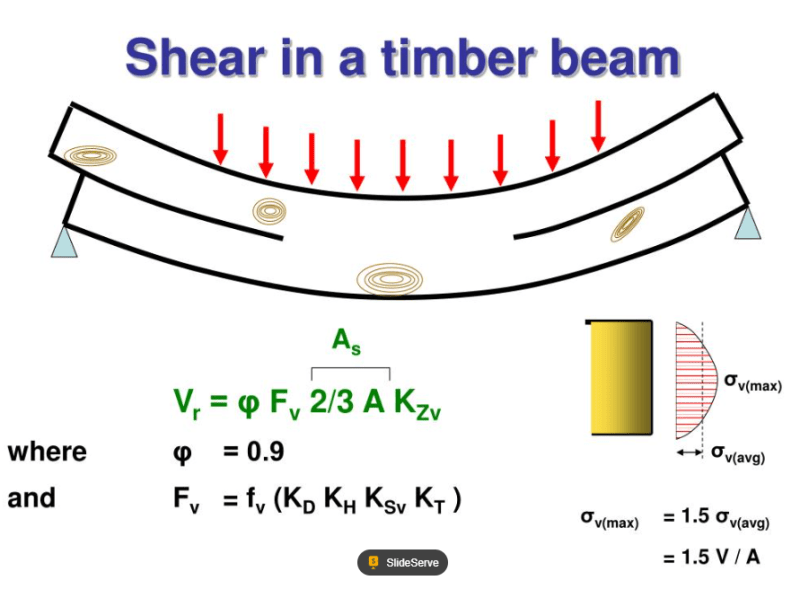
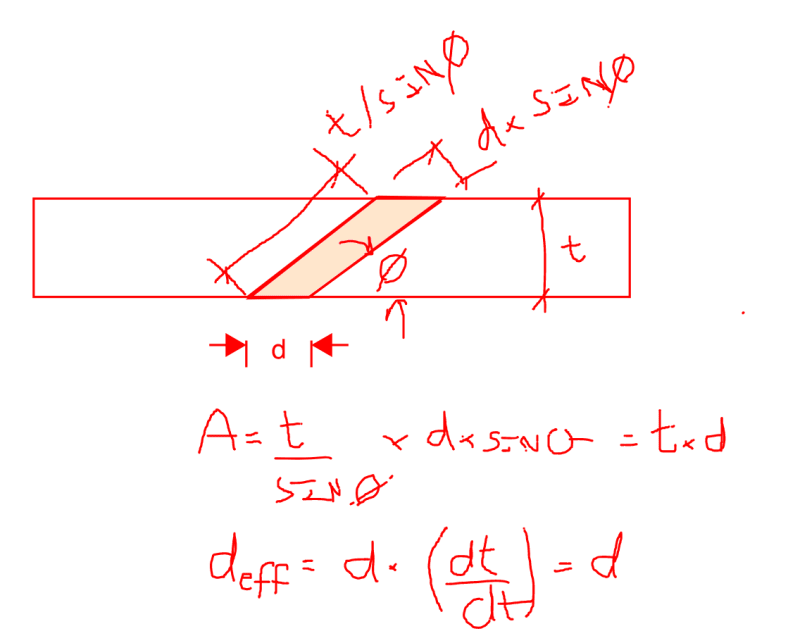
1) My understanding of non-imperfection related shear failure in wood is that it's primarily about the horizontal shear planes.
2) Following from #1, it seems to me that the parameter of interest is the amount of area lost on a hypothetical, horizontal shear plane.
3) I did a little math on #2 in an attempt to work out an effective hole diameter. Turns out that's just the regular hole diameter. Still, my 8th grade algebra/trig teacher would be proud.



-
2
- #16
- Status
- Not open for further replies.
Similar threads
- Question
- Replies
- 1
- Views
- 5K
- Question
- Replies
- 3
- Views
- 2K
- Question
- Replies
- 8
- Views
- 12K
- Replies
- 13
- Views
- 15K
- Replies
- 29
- Views
- 5K

